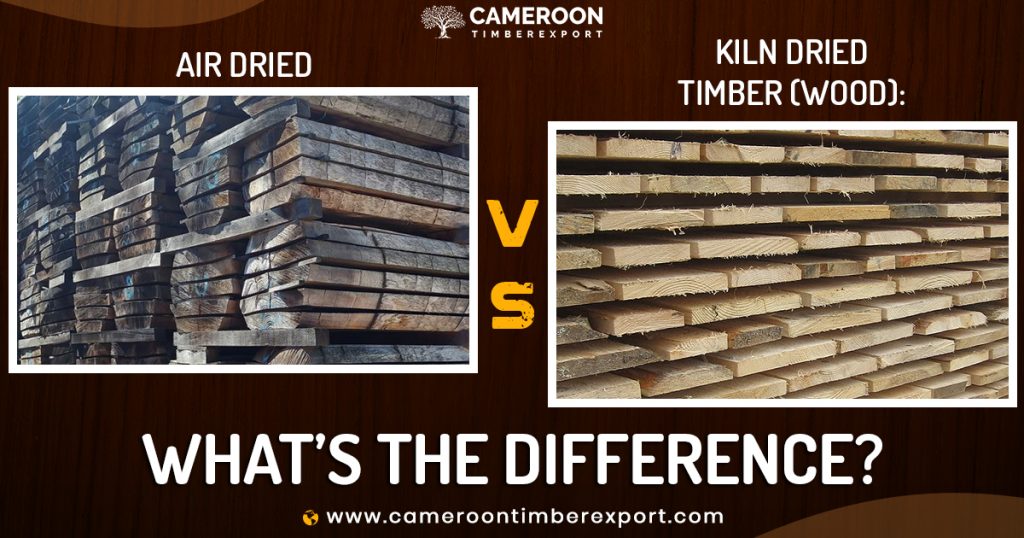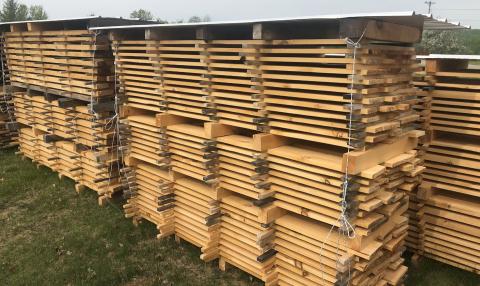As you may already know, timber generally contains natural moisture, which needs to be dried before the wood can be used for specific purposes like construction and flooring. Air Dried Vs Kiln Dried, both happen to be two of the most popular types of dried timber that have been perfected for any woodworking project.
Why Wood Needs to be Dried?
Fresh timber harvested from trees contains a large amount of moisture in it, which makes it inapt for practically any purpose, from burning to furniture making. Timber with high water content will be difficult to burn and might not be suitable for any steady use like construction, where the timber needs to be sturdy and hard. Why? Because over time, the fresh timber will start drying and lose moisture, which will make the wood shrink and change its properties, which can make the object (furniture, etc.) change its shape or become weak.
Moreover, the moisture in timber can reduce its durability and make it prone to insect attacks. For all these reasons, timber needs to be dried properly before use.
How much Drying is Needed for Fresh Timber
Any freshly harvested timber needs to be dried enough to bring the mixture levels down to 7% to 9%, which is suitable for furniture and other industrial work. Timber intended to be used for firewood should have not more than 20% moisture content.
Air Dried Vs Kiln Dried: How to Dry Wood
There are two ways to dry wood:
- Leave it and let it dry naturally
- Force dry it using methods such as kiln-drying
Let’s get to know more about the two methods of timber Drying.
Air Drying – Natural Way to Dry Wood
Air-dried timber is produced by letting the timber dry naturally through the flow of natural air by keeping it in an open space. As you can imagine, this is a slow and time-consuming process. But, it’s also the least expensive method of drying timber. Here’s how it works.
The freshly sawn wood is cut into lumbers or kept in logs, which are then arranged in layers such that each layer is separated from the other using small wooden blocks to maintain at least a 1-inch gap to allow air to pass freely between timber layers. For the air drying method to work best, timber should be kept in an open space with a good and constant flow of air. However, the area should be covered so that rain and other weather conditions do not interfere with the process or delay it further.
As one can imagine, this is a cost-effective method of wood drying, as it involves limited resources, however, the process might take a few months to more than a year depending on the wind and weather conditions in a particular region. To speed up the air drying process of timber, sometimes heavy-duty fans are used in industrial settings.
Kiln-Drying – Drying Wood Using Machines
Kiln drying is the process of drying timber by keeping it in a closed chamber called a kiln under specific temperature and humidity conditions and passing air through the wood to force the moisture out. Here’s how it works.
Timber is arranged in layers in the kiln chamber under specific temperature and humidity. Then, the air is passed through the timber by using heavy-duty fans. The temperature makes the air hot and it forces water molecules in the wood to pop out.
This is a faster way of drying wood, but it can be expensive to set up a kiln and manage resources, which is why this method is generally used in industries only. It can take a few weeks to up to a couple of months for the wood to dry completely using this method. High-density hardwoods may take longer to dry as compared to low-density softwoods.
If you are wondering what are the differences between air-dried timber and kiln-dried timber, here you go.
Air Dried Vs Kiln dried Wood
Time: As we mentioned before, air drying is a long process and may easily take up to or more than 1 year in some cases. Kiln-drying, on the other hand, is a faster way to dry wood and can be done in a few weeks’ time.
Cost: Kiln drying is expensive because it involves the use of a specific set-up, with a large chamber. Air drying is inexpensive.
Quality: The wood produced in the air-drying method is of good quality, has fewer cracks, doesn’t lose its color and would not get easily affected by mould and decay. Also, the process causes no internal tensions in the wood, so it’s easy to work with.
Kiln-dried wood is well-dried and has a low moisture content. Also, the method will remove bugs, ensuring overall better quality of wood. However, the timber might lose color after kiln drying and grains may be affected by internal tensions, which can lead to problems while working. Kiln-dried wood needs to be stored in a climate-control environment, as it will absorb moisture quickly after drying.
Resources required: Air drying requires more space but almost zero resources. Kiln drying requires less space, but it needs specific resources, including high-temperature conditions.
Control: The process and time taken in the air drying method cannot be controlled. The process and results of kiln drying can be controlled.
Uses: While air-dried timber is mainly used for fencing, outdoor furniture, patio, and decking, kiln-dried timber is used for furniture, flooring, and cabinets.
Overall, in terms of quality and results, air-dried wood is better than kiln-dried, however, the process of air-drying wood can be quite long and tiresome.
Whether you are looking to buy naturally air-dried wood or kiln-dried timber or looking for the best place to dry your wood, contact CameroonTimberExportSARL for the best timber products and services. We can provide you with top-quality wood timber as well as high-quality wood drying services at reasonable prices. Call us today to discuss.



